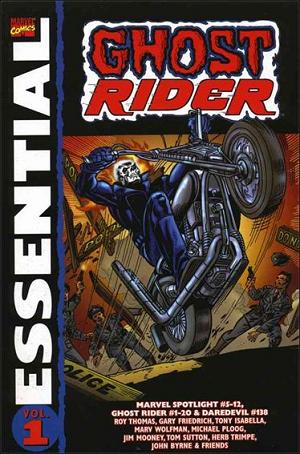
Essential Ghost Rider Vol. 1
Gary Friedrich, Tony Isabella, Michael Ploog, Jim Mooney and friends
Reprints: Marvel Spotlight #5-12, Ghost Rider #1-20 & Daredevil #138 (August 1972 – October 1976)
Get this for: Mike Ploog, Jesus and Satan — three stars
The first thing to remember about The Essential Ghost Rider Vol. 1 is that Johnny Blaze, the Ghost Rider is well, kind of a tool, as well as dumb as a bag of rocks. Created by Gary Friedrich and Mike Ploog in Marvel Spotlight #5, Johnny Blaze is the adopted son of Crash Simpson, stunt motor cyclist extraordinaire, who took him in after his own father died.
Though a natural motor cyclist himself, Blaze made a vow to his adopted mother on her deathbed not to stunt ride himself. Then Crash gets cancer, plans to do one more great stunt to make sure his daughter (Blaze’s love interest, natch) will be taken care off after his death and Johnny, unable to help out due to his vow, makes a pact with Satan to make sure his adopted father does not died of cancer, in return for his own soul. Satan cheats of course, Crash dies doing his stunt and when Satan comes to take his prize, it’s only Roxanne’s love that saves him. But that night he finds out his curse: to be transformed into the Ghost Rider!
Now this origin has been retold every time the Ghost Rider guest starred in another title and when recapped it sort of makes sense, but reading the original story here for the first time just made me realise how incredibly stupid it actually was. The vow Blaze made to his dying stepmother is dumb, but Johnny selling his soul to Satan is even worse. It’s al stated matter of factly, as if the only choice you could make in such a situation is indeed to sell your soul. As a superhero origin it sounds noble when recapped, but Johnny does it for purely selfish reasons, as he would keep doing things for purely selfish reasons as long as Gary Friedrich was writing him. He’s completely unsympathetic as a protagonist, so unsympathetic that you have to have some admiration for Friedrich to keep on writing such a character.
But there’s another aspect to Friedrich’s writing that made me uncomfortable. I don’t mind an unsympathetic hero, though Johnny Blaze did get on my nerves, but I didn’t like the worldview that Friedrich build around him. Especially in the the Marvel Spotlight stories it reminded me too much of a Jack Chick tract. Not only is it possible for a stunt cyclist to call up Satan pretty easily, but there are Indian shamans dabbling in black magic, whose daughter is herself a satanist witch woman, inducted into satanist by a cult of liberated college women, not to mention satanic biker gangs. It’s all a bit too sleazy for my liking.
I’ve never been so glad as to see Tony Isabella take over a series; he may not be the best or most original writer in the world, but at least he manages to lose that Chick tract vibe, as well as make Blaze an actual hero, of sorts. The Ghost Rider, who at that time still clearly is Johnny Blaze, unlike the more demonic figure he would become later on in the series, becomes more of a regular superhero, fighting foes like the Trapster. It’s more mundane and not so wild, but I liked it better. What I also liked is Isabella’s solution to Johnny’s struggle with Satan: a bearded, long haired hippy with a certain resemblance to you-know-who stops Satan by reminding him of the power of love. More neat Isabella touches: a demon named Slifer (Roger Slifer perhaps, or is that coincidence) and two members of the supporting cast once Johnny hits Hollywood: Wendy and Richard Pini…
Artwise, the Ghost Rider never looked as good as in his first few appearances in Marvel Spotlight, when Mike Ploog was drawing him, inked by Frank Chiaramonte. Granted, he does have the same sideburns as that other Ploog hero, Jack Russell of Werewolf by Night, but it’s gorgeous, pulpy, atmospheric art. Ploog inked by Jim Mooney on the other hand doesn’t do anything for either artist. After Ploog, it’s Tom Sutton on the art in his last few Spotlight and first solo title appearances, followed by Mooney, Herb Trimpe and Sal Buscema. In fact, these first twenty issues of Ghost Rider are a parade of Marvel most dependable if least exiting artist of the seventies. Apart from the ones mentioned above, there’s also Frank Robbins, Bob Brown and George Tuska. Only at the very end, in the two part crossover with Daredevil, written by Marv Wolfman and penciled by John Byrne does the art even come close to the standard Ploog set. Byrne is completely the wrong kind of artist for Ghostie though, much too realistic.
Essential Ghost Rider Vol. 1 then shows the evolution of a flawed but original concept into something that’s much more closer to a standard Marvel anti-hero, with his demonic possession degraded to his version of the standard Marvel Hero Handicap. Nothing that’s really unmissable, but Ghost Rider was a mainstay of seventies Marvel, so recommended reading for anybody interested in that era.